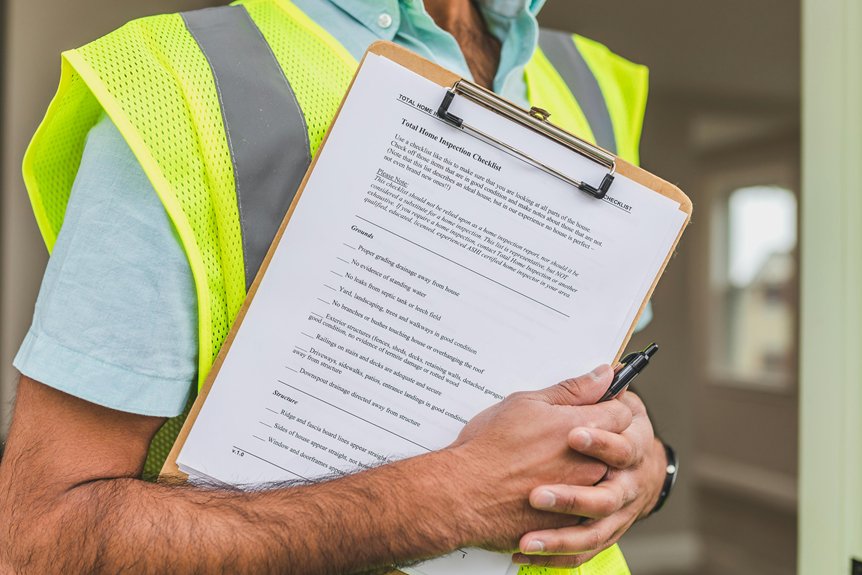Maintaining your home can seem overwhelming, but breaking it down into essential tasks makes it manageable. You’ll want to start by inspecting and cleaning your gutters to avoid costly water damage. Next on your list should be checking your HVAC systems to guarantee efficiency. These tasks are just the beginning, and neglecting them could lead to bigger issues later. Let’s explore what else you need to include in your home maintenance routine.
Key Takeaways
- Inspect and clean gutters at least twice a year to prevent water damage and ensure proper drainage.
- Conduct HVAC system checks seasonally, replacing filters every 1-3 months for optimal performance.
- Test smoke and carbon monoxide detectors monthly and replace batteries twice a year to maintain safety.
- Schedule plumbing inspections regularly to detect leaks early, saving money and preventing damage.
- Perform routine pest control inspections to identify and address potential infestations before they become problematic.
Inspect and Clean Gutters

One of the essential tasks in home maintenance is inspecting and cleaning your gutters at least twice a year.
To begin, gather your tools: a sturdy ladder, gloves, and a scoop for debris removal. Climb safely to check for clogs, leaves, and other debris that can hinder water flow. Remove any accumulated debris to prevent water damage to your roof and foundation.
Once cleaned, flush the gutters with water to guarantee proper drainage. Don’t forget to examine downspouts for blockages as well.
Regular gutter maintenance protects your home and saves you from costly repairs down the line.
Check HVAC Systems
Before the seasons change, checking your HVAC systems is essential to confirm a comfortable home environment year-round.
To maintain HVAC efficiency, focus on these key tasks:
To ensure your HVAC system runs smoothly, prioritize regular maintenance tasks like filter replacement and duct inspections.
- Replace filters: Change your filters every 1-3 months to guarantee ideal airflow and air quality.
- Inspect ducts: Look for any leaks or blockages that could hinder performance.
- Schedule a professional tune-up: An expert can identify potential issues and enhance system efficiency.
Test Smoke and Carbon Monoxide Detectors
Testing your smoke and carbon monoxide detectors is essential for your safety, as these devices can save lives in case of an emergency.
It’s recommended to test them at least once a month and replace the batteries twice a year to guarantee they function properly.
Importance of Regular Testing
While many homeowners might overlook it, regularly testing smoke and carbon monoxide detectors is essential for guaranteeing your family’s safety.
These simple testing procedures can save lives and provide peace of mind.
To help you establish effective safety measures, consider the following:
- Test alarms monthly to guarantee they’re functioning properly.
- Replace batteries at least once a year to avoid failures.
- Replace detectors every 10 years, as they can lose effectiveness over time.
Recommended Testing Frequency
Establishing a reliable testing routine for smoke and carbon monoxide detectors is essential for maintaining a safe home environment. Aim to test these devices at least once a month to verify they’re functioning properly.
Consider setting specific testing intervals, like the first of each month, to make it a habit. During your routine assessments, simply press the test button on each detector to confirm it’s working.
If you hear a beep, you’re good to go! If not, consult your user manual for troubleshooting tips.
Regular testing not only enhances safety but also provides peace of mind for you and your family.
Battery Replacement Tips
Changing the batteries in your smoke and carbon monoxide detectors is essential for guaranteeing they operate effectively.
To keep your home safe, follow these tips for battery replacement:
- Know your battery types: Most detectors use 9V or AA batteries. Check your device’s manual for specifics.
- Set a replacement frequency: Replace batteries at least once a year, or every six months if you live in an area with frequent power fluctuations.
- Test detectors monthly: Press the test button to confirm functionality and guarantee your detectors are ready to alert you in emergencies.
Stay proactive about your home safety!
Service the Water Heater

To keep your water heater running efficiently, you should regularly service it by flushing the tank to remove sediment buildup.
Next, check the anode rod, as it helps prevent corrosion and prolongs the unit’s lifespan.
Finally, inspect the temperature settings to guarantee they’re safe and energy-efficient.
Flushing the Tank
Flushing the tank of your water heater is an essential step in maintaining its efficiency and longevity.
Regular tank maintenance helps prevent sediment buildup, which can lead to decreased performance.
Here are some effective flushing techniques you can use:
- Turn off the power supply or gas to the heater.
- Attach a garden hose to the drain valve and run it to a floor drain.
- Open the drain valve and let the water flow until it runs clear.
Checking Anode Rod
The anode rod plays an essential role in protecting your water heater from corrosion, extending its lifespan considerably.
You’ll want to check it at least once a year. Start by turning off the power and water supply.
Then, remove the rod from the tank using a socket wrench. Inspect it for signs of wear or significant corrosion—if it’s less than 1/2 inch thick, it’s time for an anode rod replacement.
Replacing it regularly is vital for effective corrosion prevention, ensuring your water heater operates efficiently and lasts longer.
Don’t overlook this simple task; it can save you money in the long run.
Inspecting Temperature Settings
After verifying your anode rod is in good condition, the next step in servicing your water heater is inspecting the temperature settings.
Proper temperature calibration can prevent energy waste and scalding risks.
Check the following:
- Thermostat placement: Confirm it’s positioned correctly for accurate readings.
- Temperature setting: Ideally, set your water heater to 120°F for efficiency and safety.
- Regular monitoring: Check every six months to maintain peak performance.
Inspect Roof and Attic
How often do you take a moment to inspect your roof and attic? Regular inspections can prevent costly repairs.
Check your roof shingles for any signs of damage, such as cracks or missing pieces. These issues can lead to leaks and mold growth.
In the attic, guarantee proper attic ventilation to prevent moisture buildup. Look for signs of water stains, which may indicate leaks. Inspect insulation for wear and verify it’s evenly distributed.
Clean and Seal Windows and Doors
To keep your home energy-efficient, start by inspecting your windows and doors for any gaps.
If you find any openings, applying weatherstripping materials is a straightforward solution that can greatly reduce drafts.
This simple maintenance task not only improves comfort but also helps lower energy bills.
Inspect for Gaps
While you mightn’t notice them at first glance, gaps around your windows and doors can lead to significant energy loss and increased utility bills.
Regularly inspect these areas to guarantee efficient gap sealing. Use draft detection techniques, like feeling for cold air or using a candle flame, to identify any leaks.
Here are key steps to follow:
- Check for visible cracks or spaces in frames.
- Inspect weatherstripping for wear and tear.
- Use caulk for any gaps that need sealing.
Apply Weatherstripping Materials
When you tackle weatherstripping around your windows and doors, you’ll not only improve energy efficiency but also enhance your home’s comfort. Start by choosing the right weatherstripping materials suitable for your needs.
| Material Type | Application Area |
|---|---|
| Foam Tape | Uneven gaps |
| V-Seal Weatherstrip | Double-hung windows |
| Door Sweeps | Bottom of exterior doors |
| Magnetic Strips | Metal doors |
Clean the surfaces thoroughly before applying the materials, ensuring a tight seal. Regularly inspect your work to maintain the benefits of improved energy efficiency and comfort throughout the year.
Maintain Landscaping and Yard
Maintaining your landscaping and yard is essential for enhancing your home’s curb appeal and ensuring a healthy outdoor environment.
Proper landscaping maintenance boosts your home’s curb appeal and promotes a thriving outdoor space.
Regular lawn care and garden maintenance keep your outdoor space vibrant and inviting. Consider these key tasks:
- Mow the lawn regularly and edge for a clean look.
- Prune shrubs and trees to encourage healthy growth and shape.
- Mulch garden beds to retain moisture and suppress weeds.
Check Plumbing for Leaks
After sprucing up your landscaping and yard, it’s time to turn your attention indoors and check your plumbing for leaks.
Start by inspecting visible pipes under sinks, around the toilet, and in the basement. Look for water stains, mold, or rust, as these can indicate a leak.
Don’t forget to check your water meter; if it’s running when no water is in use, you might’ve a hidden leak.
Regular leak detection is essential for effective plumbing maintenance, as it can save you money and prevent damage.
If you find any issues, consider calling a professional for repairs.
Inspect Electrical Systems

Inspecting your electrical systems is an essential step in maintaining a safe and efficient home.
Regular circuit inspections help prevent hazards and guarantee everything operates smoothly. Here are key areas to focus on:
- Check outlets and switches for signs of wear or damage.
- Test GFCI outlets to verify they’re functioning correctly, enhancing electrical safety.
- Examine your circuit breaker for tripped switches or unusual noises.
Schedule Pest Control
Pest control should be a regular part of your home maintenance routine to keep unwanted critters at bay.
To effectively implement pest prevention strategies, schedule a professional inspection at least twice a year. This guarantees any potential infestations are caught early.
During inspections, focus on common entry points like windows and doors. You can also adopt proactive measures, such as sealing cracks and keeping food stored securely.
If you notice signs of pests between inspections, don’t hesitate to call an expert.
Conclusion
By staying on top of these ten key tasks, you’re ensuring your home remains safe, efficient, and well-maintained. Regular inspections and maintenance not only prolong the life of your systems but also save you money and headaches down the road. Make it a habit to check off these items on your home maintenance checklist throughout the year. Your diligent efforts will pay off in comfort and peace of mind, allowing you to enjoy your home to the fullest.

